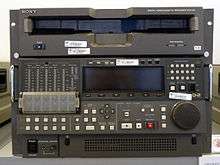D-2 (video)
|
Sony D-2 VCR | |
| Media type | Magnetic Tape |
|---|---|
| Encoding | digital composite video |
| Read mechanism | Helical scan |
| Write mechanism | Helical scan |
| Standard | interlaced (NTSC, PAL) |
| Developed by | Ampex/Sony |
| Usage | Video production |
D-2 is a professional digital videocassette format created by Ampex and introduced at the 1988 [1] NAB (National Association of Broadcasters) convention as a composite video alternative to the component video D-1 format. It garnered Ampex a technical Emmy in 1989.[1] Like D-1, D-2 stores uncompressed digital video on a tape cassette; however, it stores a composite video signal, rather than component video as with D-1. While component video is superior for advanced editing, especially when chroma key effects are used, composite video is more compatible with most existing analog facilities.
History
Ampex created the first D-2 video machine, the ACR-225 commercial spot player[2] working with Sony, who had done some early research into composite digital video,[3] as a cost-effective solution for TV broadcasters with large investments in composite analog infrastructure such as video routers and switchers, since it could be inserted into existing analog broadcast facilities without extensive redesign or modifications. This was because D-2 machines accepted standard analog video and audio inputs and outputs. D-2 machines are capable of interfacing through either serial digital video or analog video connections. Four PCM audio channels are available for editing (an improvement over the then-popular Type C analog machines with two audio channels) as well as an analog cue channel and timecode, also with digital or analog connections.
Features
Like D-1, D-2 uses 19 mm (¾ inch) tape loaded into three different sized videocassettes to support commercial spot playback as well as long-form programming such as movies. Although D-2 videocassette housings are nearly identical to their D-1 counterparts, they are not interchangeable due to D-2's metal particle tape formula, needed for its higher recording density.[2]
Ampex D-2 tape transports are extremely fast. A high speed search at 60 times playback speed with a recognizable color picture allowed three hours of videotape to be searched through in approximately three minutes.
The D-2 offered read before write or preread functionality, which allowed simultaneous playback and recording on the same transport.[4] For example, a title could be superimposed over existing video already on the same video tape by playing the tape through a video switcher, adding the title, and recording the new composite image back onto the same location of the tape. This eliminated the need for an additional recorder and saved considerable time in video editing. Steven Fuiten was the first PreRead Editor to composite video using a full D2 digital system.
Acceptance
During its early stages, finished episodes of South Park were hastily recorded to D-2 to be sent to Comedy Central for airing in just a few days' time.[5]
D-2 had a relatively brief heyday, as the computer-based video server (with far fewer moving parts and correspondingly greater reliability) became available soon after its release. In 2003, only a handful of broadcasters continued to use the D-2 format, and even then only to access materials recorded when the format was more popular.
Panasonic's competing composite digital format is known as D-3.
Format Description
- General:
- Format name: D2 digital
- SMPTE type: D2
- Format type: digital composite
- Scanning system: multi head segmented helical
- Year introduced: 1989
- Developer: Ampex/Sony
- Physical Data:[6]
- Tape width: 19 mm
- Tape speed(s): 5.19 ips
- Tape thickness: .55 mils
- Playing time(s): 32, 94, 208 minutes (Small, Medium, Large cassette sizes)
- Headwheel diameter: 2.95"
- Speed: 5400 rpm
- Head-to-tape writing speed: 1078 in/sec.
- Sampling rate: 4fsc (14.31818 MHz for NTSC)
- No. of bits 8
- Data rate: 60.1 MB/sec
- Audio:
- No. of digital channels: 4
- Sampling rate: 48 kHz
- No. of bits: 20
Models

- Ampex
- VPR-200, VPR-250, VPR-300
- ACR-225 Commercial Spot Player (robotic tape system)
- Sony
- DVR-10, DVR-18, DVR-20, DVR-28
- DCR-10, DCR-18, DCR-20, DCR-28 (sold by BTS)
- DVC 80, DVC 1000s LMS (Library Management System)
References
- 1 2 "Ampex History". Ampex. Retrieved 14 September 2013.
- 1 2 Watkinson, John (1990). The Art of Digital Video. Focal Press. ISBN 0-240-51287-1.
- ↑ Watkinson, John (1990). The D-2 Digital Video Recorder. Focal Press. p. 5. ISBN 0-240-51302-9.
- ↑ "Ampex history: 1988". Ampex. Retrieved 18 September 2013.
- ↑ "The Making of South Park". South Park Scriptorium. Retrieved 15 September 2013.
- ↑ (multiple authors). "Videotape Formats". LionLamb. Retrieved 19 September 2013.
External links
- allmobilevideo.com: D2 Specs
- Google Books: The History of Television, 1942 to 2000 By Albert Abramson
- Google Books: The Art of Digital Video, by John Watkinson
- lionlamb.us: Ampex Digital VTR Catalog
- lionlamb.us: Ampex ACR-225
- tech-notes.tv: Ampex history
- ampex.com: Ampex history
